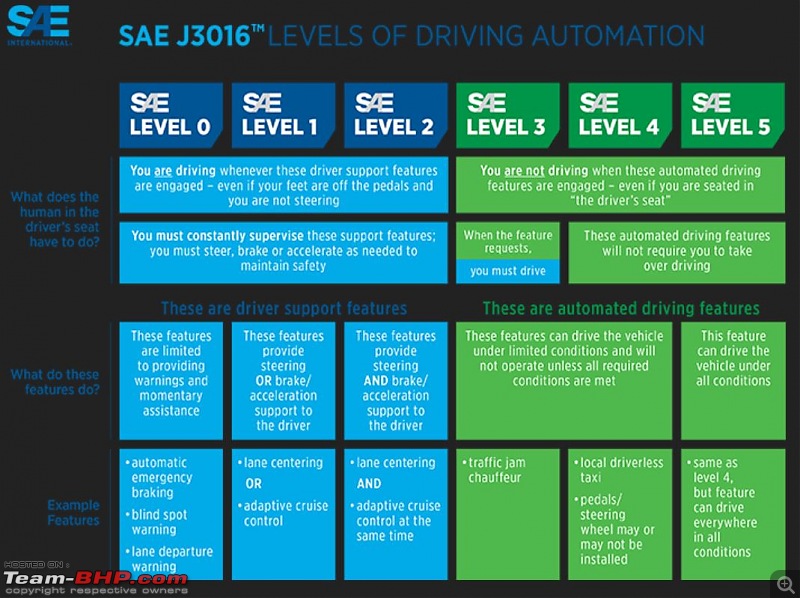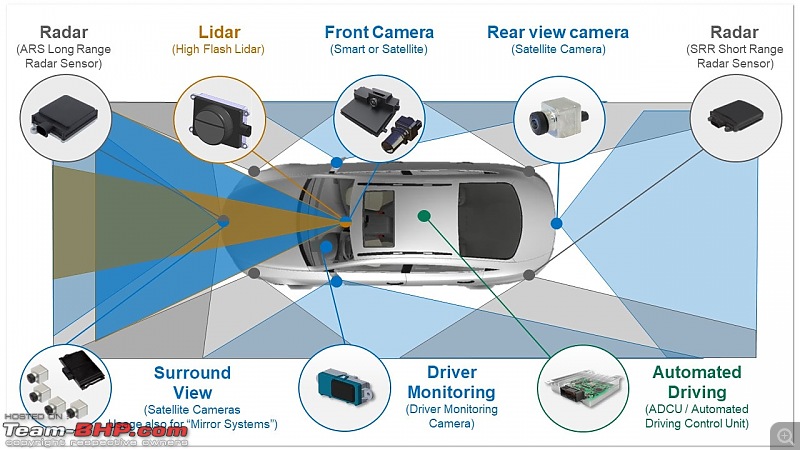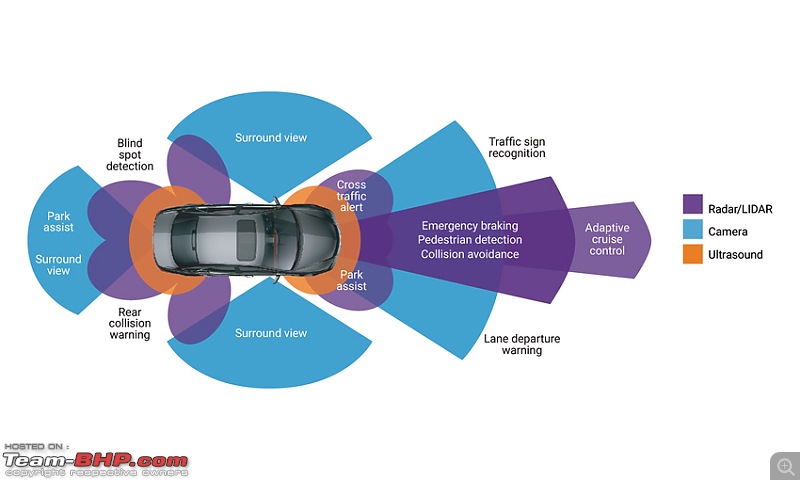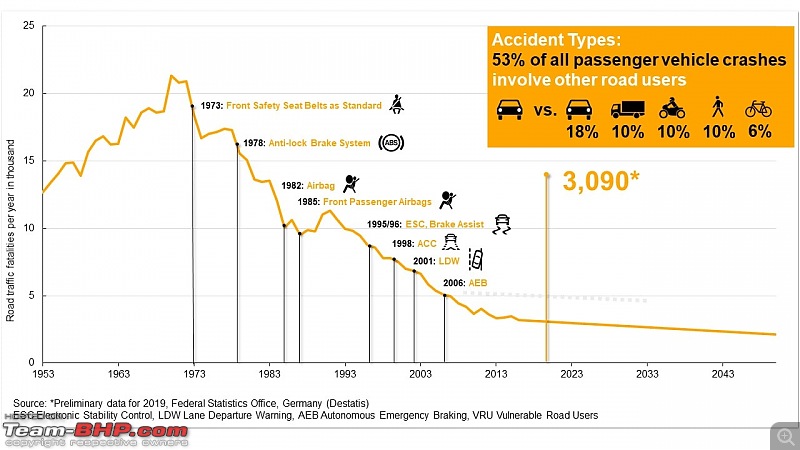| |||||||
 |
| Search this Thread |  9,452 views |
| | #1 |
| BHPian Join Date: Apr 2019 Location: Bangalore
Posts: 535
Thanked: 3,832 Times
| Understanding Autonomous Technology and ADAS With the advancement of electronics and software, the days of good old plain and simple mechanical and electrical systems on our daily commuters and dear touring vehicles were ended and most of the modern cars that we use are controlled with electronic control units via sensors and actuators. But till this day for an average car, they just translate the action of the user. Now, with even more advancements made in the field of Artificial Intelligence and complex electronic hardware, we are witnessing the start of penetration of the autonomous technology into our daily cars (even though currently a niche segment). What started as driver assist systems for reducing the accidents on the road has come a long way and extended to autonomous driving even without human interference. But the words, driver assistance, automated, autonomous, self-driving which we discuss a lot look similar but are quite different. There is a widespread misunderstanding of the features and with the OEMs now starting to launch these advanced systems into the Indian market (MG Gloster and upcoming Mahindra XUV5OO), we must be aware of the technicalities a bit to not get mislead by their marketing and ads. This thread can be used to discuss all upcoming technologies & features related to ADAS and autonomous driving. Benefits of autonomous transportation: The potential for dramatically lowering CO2 emissions and others. But when a recent study by itdp was conducted combining autonomous technology with EVs and ridesharing will have greater benefits in 2050, • Reduce traffic congestion (30% fewer vehicles on the road) • Reduce transportation costs by 40% • Improve walkability and livability • Free up parking lots for other uses • Reduce urban CO2 emissions by 80% worldwide  Before going further, let me try to put some clear differences between the technical jargons that I used earlier, and with the basic requirements and feature explanation. Self-driving: self-driving car can drive itself in some or even all situations, but a human passenger must always be present and ready to take control. Autonomous driving: A fully autonomous car would be self-aware and capable of making its own choices. To identify and have some regulations the SAE (Society of Automotive Engineers) has classified the autonomous technology into different levels. From level 0 (no autonomy) to level 5 (full autonomy) and in each level what will be the expectation & responsibility from driver or the system. I will let the table in the image do the explaining.   Level 0: Full manual control, The driver is responsible for all the actions like in today’s cars which we drive. But where these cars vary from our cars is that the system will alert you for example leaving the lane or collision warning, autonomous emergency braking (this comes here because its not a driving function). Level 1: Driver Assistance This is the first step for some automation, driver is very much involved but the systems can complement few driver actions but not complete functionality. Cruise control and ACC are examples as the car is just controlling accelerator variation and driver is doing everything else from steering to braking. Level 2: Partial Automation This level is the beginning for autonomous control, based on basic input from driver the car can do steering, acceleration and braking all by itself with driver still in control if he needs to. ACC stop and go, Autonomous emergency steering, lane keep, and change assist comes under this level. Level 3: Conditional automated driving Level 3 is where the real differentiation stars, the feature can work on its own when requested in most conditions (mapping environment) and need driver in exceptional cases. Example traffic jam pilot, where the car can follow another car changing course and even overtaking if free space is detected. Level 4: High automated driving These are called self-driving vehicles using a wide variety of functions to drive by themselves without human interference but allow the human driver to take control if he needs to. Level 5: Full autonomous driving There is no human driver requirement for this level, can eliminate all controls related to driving like steering wheel or brakes. These are the vehicles where you can sleep and wake up in another place. Since full autonomous vehicles are beyond the timelines of basic ADAS featured vehicles, I will address the technical structure and content in ADAS section. Last edited by saikarthik : 23rd December 2020 at 21:35. Reason: Picture clarity |
| |  (34)
Thanks (34)
Thanks
 |
| The following 34 BHPians Thank saikarthik for this useful post: | 123.rishabh, 2000rpm, ach1lles, AdityaDeane, adroit_91, akshye, AmitRavi07, audioholic, AYP, Beelzebub, Bibendum90949, Dr.AD, EightSix, GeneralJazz, GKR9900, Godzilla, GRAND23, GTM, GTO, gusfring, klgiridhar, landcruiser123, nikhn, ph03n!x, procrj, Rajeevraj, rajvardhanraje, RBalaM, Researcher, sandeepmohan, sarathlal, Shrayus_shirali, SuhairZain, Swarup5 |
| |
| | #2 |
| BHPian Join Date: Apr 2019 Location: Bangalore
Posts: 535
Thanked: 3,832 Times
| re: Understanding Autonomous Technology and ADAS ADAS: Advanced Driver Assist SystemNow this is what most of us are interested in and more relevant to India as we are seeing the products on road now. Basically, one or two features creeped into the vehicles here and there before but the latest entrant in D2 segment MG Gloster had launched it as a package. ADAS itself is very vast and has dozens of features in it but mostly we can segregate into in my own view, 1. Driving assistance, 2. Object detection and Collision avoidance, 3. Road signs and Speed limits, 4. Lighting and other passive systems (ESP – has HDC/HHC, TPMS), 5. V2X – a different concept but integrates with ADAS functions. We shall come back for feature explanation, but before that let me list down certain key points, 1. ADAS interacts with other ECUs and collects/communicates via CAN or Ethernet and cannot function alone. 2. HMI (driver controls and information) may be through instrument cluster or additional hardware. 3. When V2X and ADAS comes on a car, more emphasis is given to cybersecurity and functional safety. 4. There are pre-requisites for certain features to perform, just with ADAS ECU and sensors it cannot give desired result. Example – for Lane keep assist, electronic power steering is mandatory, and for AEBS- ESP is mandatory. 5. ADAS hardware cannot be retrofitted or introduced into a car without some prior design protection. 6. There is a lot of focus on integration with mechanical systems which you may have not even imagined, so modification in aftermarket will be tough. Everyone will have queries on which additional parts are needed for ADAS, so let me just show it with a picture and the functions possible with each sensor.   So, from the above pictures we can get an idea how a manufacturer can choose the hardware required for the features as some components can perform to provide multiple functions and some functions need multiple sensors to give a proper result. If multiple sensor inputs are combined for a feature, then it is called sensor fusion. Sometimes all the sensors can be connected to a single powerful controller to perform all decision making. It depends on various factors including the cost and development strategy. Also, each sensor has its own advantage and disadvantage and on higher terms, Camera: Vision based, so the weather and dust will affect its performance. Usually good for object classification with range up to 150 meters. Even the low light performance is good now. Can perform many functions. Radar: Radio frequency based in mm range. Less affected by weather and has longer range. More accurate on distance and speed analysis. Poor border definition so object classification is not so good. Lidar: Laser pulse based, expensive, medium range and better environment 3D mapping and object classification. Now let us get down to features and their explanation. I will just stick to high level and the 5 sections mentioned above as explanation for regular features is vast and repetitive with a ton of material available online (links will be shared). And one example on how sensors get the information, processed and actuation is done. 1. Driving assistance features: These help by freeing up the driver to make only important controls. Most of the features need Lane markings, road edge detection and free space calculation.  Some notable features are, a. Cruise control – There are multiple levels from simple acceleration control (fixed speed), to Adaptive cruise (maintaining a headway with the vehicle in the front). ACC stop and go (complete halt and resume). Some even recognize the speed limits of the road and vary the set speed themselves so that the driver will not get a speeding ticket. Typical Sensors: Front ADAS Camera, Radar (not compulsory, but better results). Typical Controls: Acceleration and deceleration via Engine control, braking and brake lights. b. Lane Support systems – Again, there are many levels. First is the lane departure warning, where only warning is given, and driver needs to act. Secondly, Lane keep assist, where the system keeps the vehicle in lane. Third, Lane centering assist -this is for perfectionists and I can be sure that Germans would have come up with this feature. Maintains the vehicle equidistant between two lanes. Fourth, Lane change assist, you just must turn on the indicator and the vehicle will move to the next lane if there are no vehicles in the path. Typical Sensors: Front ADAS Camera, ORVM mounted cameras or sensors. Typical Controls: Steering via EPS, Indicator control and driver HMI. c. Blind spot detection system – This can be helpful for both lane changes and even collision avoidance or parking. Typical Sensors: ORVM mounted cameras or sensors, rear and front ultrasonic sensors. Typical Controls: Driver HMI. 2. Object detection and Collision avoidance: These features can make life and death decisions, and this is where most of the debate currently is going on in almost all international regulatory forums. As this is very vast and complex, let me just post few pictures. Basically, the radar, lidar and camera map the complete environment and track all the objects and their motion. They then calculate time to collision if collision is imminent and issue a warning to driver before braking. There are categories in object classification – static (poles and trees, walls and what not) and dynamic (Cars, pedestrians, cyclists) with even more scenarios if they are moving, braking, coming from near side or far side and etc…   Typical Sensors: Camera, Radar, Lidar. Typical Controls: Driver HMI, braking via ESP. 3. Road signs and Speed limits: These features come in handy for avoiding penalties in case if one misses noticing important road signs on a highway or city. The camera unit senses the traffic signs and can either warn the driver or reduce the speed by themselves. Note that it is not just speed limits there are literally dozens of road signs from “give way to stop” Typical Sensors: Camera, Navigation and vehicle speed. Typical Controls: Driver HMI, braking via ESP. I am limiting the explanation to the first 3 sections and please go through the following wiki link for more features. https://en.wikipedia.org/wiki/Advanc...stance_systems I hope that this thread will be useful for basic understanding on ADAS and we can continue to discuss the upcoming features in different vehicles that are introduced in India/other locations. Image credits and Sources: Continental official site, Google. |
| |  (26)
Thanks (26)
Thanks
 |
| The following 26 BHPians Thank saikarthik for this useful post: | AdityaDeane, AmitRavi07, aniyo, audioholic, Dr.AD, frewper, GeneralJazz, Godzilla, GRAND23, GTM, GTO, gusfring, Jeroen, klgiridhar, landcruiser123, LoneWolf9, nikhn, nitinkbhaskar, ph03n!x, Rajeevraj, RBalaM, Researcher, sarathlal, Shrayus_shirali, surjaonwheelz, VinNam |
| | #3 |
| Distinguished - BHPian  | re: Understanding Autonomous Technology and ADAS Thanks for a very informative post. It is interesting to see the reduction in accidents by introduction of various new technology. The one aspect that I believe is not getting due attention is the human factor in the current phase where cars are becoming essentially autonomous but still require human oversight. It is a very dangerous phase. For no other reasons, humans are extremely poor at these sort of routine tasks. We have seen a number of horrific accidents where the car was driving in autonomous mode and the driver was not paying enough attention and did not respond well. Depends on who’s research you want to believe, but typical driver response time is around 1,5 - 2,3 seconds. That is for drivers actively engaged in driving. What it means is you see something happening and it takes anywhere between 1,5 -2,3 seconds before you undertake any major action, such as braking. This is with normal reasonable attentive drivers. With (semi) autonomous cars, drivers attention will drift away and they will be talking to somebody, busy on their phone etc. So response times are going up tremendously under these circumstances. Even to date in other industries that rely heavily on automation (e.g. pilots, process operators) the way human intervene into an automated process is often cause of concern and more often leads to catastrophic outcomes. There is no doubt in my mind that autonomous driven car are the way forward. But we are going to see some horrendous accidents because the automative industry has way too little experience and way to little research ongoing into the human behaviour part. It is all about the technology and about legislation. As always the real weakest link is the driver. A pilot learns to fly in full manual mode, no automation. Throughout his/her career through courses, experience, endorsements etc you learn how to start using more and more automation. There are only a few countries in the world who today have GPS navigation as a mandatory skills as part of a driving curriculum and driving test. Similar to for instance use of ABS. As we move forward to fully autonomous cars, the driving curriculum, schooling etc needs to amended to reflect the technology being deployed. Jeroen |
| |  (17)
Thanks (17)
Thanks
 |
| The following 17 BHPians Thank Jeroen for this useful post: | AdityaDeane, AmitRavi07, bikertillidie, Dr.AD, frewper, gauravanekar, GeneralJazz, GTO, landcruiser123, nikhn, ph03n!x, procrj, Researcher, saikarthik, sandeepmohan, sarathlal, VinNam |
| | #4 |
| Distinguished - BHPian  Join Date: Aug 2011 Location: Bangalore
Posts: 4,606
Thanked: 17,681 Times
| re: Understanding Autonomous Technology and ADAS Good summary. Since I am involved a bit in this space some more points to add. While Autonomous driving (Above Level 3) is a long way away- especially in India, ADAS is something that is starting to gain traction. When we talk about ADAS, there are two approaches. The OEM approach: Where ADAS features is integrated into the vehicle as part of the design and manufacturing. Most OEM's work with specialists around ADAS and AD (Example: Mobileye) to build the design and integration from the grounds up targeted to specific vehicle modes. Many OEMs also have their in house ADAS and AD divisions (Eg: Mercedes Benz). Key Points
The After-Market approach: This approach is now gaining traction in the Indian market. This basically means you can bring in ADAS functionality to any vehicle through an after market install. Several companies are trying to do this in India (Example: Mobileye, Sixth Sensor, Netradyne) Key points:
In addition, apart from the private vehicle owners, where ADAS in my view is going to play a major role is with respect to the commercial and public transport segment. Realtime alerting to the driver(most studies have shown that 2-3 seconds of warning to a distracted driver can save 80% of rear end collisions) combined with offline data analytics can help in bringing about safer driving practices which in turn can reduce accidents. India is one of the worlds top countries in accidents with 400,000+ accidents last year(reported ones) and also accounts for 11% of accidents worldwide. So reliable and effective collision avoidance systems will definitely help. Last edited by Rajeevraj : 24th December 2020 at 00:07. |
| |  (11)
Thanks (11)
Thanks
 |
| The following 11 BHPians Thank Rajeevraj for this useful post: | AdityaDeane, AmitRavi07, Bibendum90949, GeneralJazz, GTO, ph03n!x, procrj, Researcher, saikarthik, sarathlal, VinNam |
| | #5 | ||
| BHPian Join Date: Apr 2019 Location: Bangalore
Posts: 535
Thanked: 3,832 Times
| re: Understanding Autonomous Technology and ADAS Quote:
Absolutely, a worrisome point. The driver should be well educated on the use of these features and even so, there are few issues. Now, imagine having few cars with ADAS on road, and they take action to avert a collision (an emergency braking act) there is still a chance that the car will get into rear end collision from vehicle without ADAS coming with no headway. Drivers should be held responsible for any incidents as these are support features (unless it is due to technical fault). Educating and familiarizing new drivers is a long term process and should be started as early as possible before deployment of such solutions. Quote:
It has become a monopoly sort of situation with Mobileye, so many OEMs are trying to bring other suppliers to reduce the cost. But none at present are at the level of Mobileye, even if the performance is more or less satisfactory. | ||
| |  (2)
Thanks (2)
Thanks
 |
| The following 2 BHPians Thank saikarthik for this useful post: | AmitRavi07, GTO |
| | #6 |
| Distinguished - BHPian  Join Date: Aug 2011 Location: Bangalore
Posts: 4,606
Thanked: 17,681 Times
| re: Understanding Autonomous Technology and ADAS Just adding some more info on ADAS alert terminologies and what they mean: Forward Collision Warning (FCW): This is a standard warning from any ADAS system. Mostly refers to rear end collisions with the vehicle in front. The basic framework is getting the speed of the vehicle, being able to identify vehicles, objects and pedestrians in front and then being able to measure the distance to them and calculate a time to collision metric. The success of the system lies in how fast and accurately it can do this because the object in question and the relative speeds will constantly change and the system must be able to comprehend, process and alert extremely quickly if a collision can happen in x seconds. For an aftermarket system the post install calibration is critical. For example you need to account for the distance between the point of install and the front most point of the car (the front of the bumper). This is why Dashcams that claim to have FCW are totally inaccurate. Forward Collision Warnings also are configured to be active above certain speeds. (Example 30kmph). Below that, alerts are disabled or are more softer beeps when very close to vehicle in front (Also called Urban FCW). The same concept applies to Pedestrians also and is then called a Pedestrian collision warning(PCW). Headway Monitoring: This is more to ensure that you keep a safe distance and do not potentially get into a collision situation and helps reduce tailgating. The system normally keeps monitoring the headway to the vehicle in front and once it drops below ~2.5 seconds, either alerts or displays appropriately and this gets progressively urgent if the gap keeps closing. Lane departure warnings(LDW): Mostly flags unintentional departure from the lane. Unintentional means without switching on the indicator and typically above certain speeds. Traffic Sign Recognition(TSR): Mostly for camera based ADAS systems which can read common road signs and display them as information to the driver. Mostly common TSR are the speed limit signboards which can be read and displayed. Additionally some systems can alert if the speed is exceeded by certain amounts. Unlike the fixed 80/120 kmph chimes, this is more dynamic in nature. Last edited by Rajeevraj : 24th December 2020 at 16:35. |
| |  (3)
Thanks (3)
Thanks
 |
| The following 3 BHPians Thank Rajeevraj for this useful post: | GTO, procrj, Researcher |
| | #7 | |
| BHPian Join Date: Oct 2019 Location: Gurgaon
Posts: 153
Thanked: 1,505 Times
| Re: Understanding Autonomous Technology and ADAS Quote:
| |
| |  (3)
Thanks (3)
Thanks
 |
| The following 3 BHPians Thank 123.rishabh for this useful post: | audioholic, bikertillidie, saikarthik |
| | #8 |
| BHPian Join Date: Aug 2021 Location: Mysuru
Posts: 93
Thanked: 486 Times
| Re: Understanding Autonomous Technology and ADAS Bhpians , Could someone enlighten the forum on how crash tests would work with ADAS working in parallel. Theoretically, it isn't possible to crash with Auto emergency braking in place. Going by the YouTube videos of how well these systems recognize obstacles , the crash test block would certainly trigger auto braking  How would the future of Crash test ratings be established is an interesting area of discussion. The likes of XUV 700 and MG have a huge advantage with these smart systems already in place, which gives them a clear upper hand when it comes to those vehicles which don't come equipped with such features. Thanks, |
| |  (1)
Thanks (1)
Thanks
 |
| The following BHPian Thanks Swarup5 for this useful post: | akn1984 |
| | #9 |
| BHPian Join Date: Jan 2011 Location: IXE/FRA
Posts: 27
Thanked: 54 Times
| Re: Understanding Autonomous Technology and ADAS Below are some videos from my YouTube channel demonstrating Adas features like ACC and Lane Keep Assist on the newly launched MG Astor. I tend to use ACC more on the highways and sometimes in the city when there is stop go traffic. However detection of motorbikes is sometimes an issue and other times even though the motorbike is detected, the system is not good enough to judge that it can drive through (as the motorbike is in the left edge of the driving corridor mostly). |
| |  ()
Thanks ()
Thanks
 |
 |


